How Efficiency Margin Is Impacting Team Résumés Under the NCAA's NET Rankings
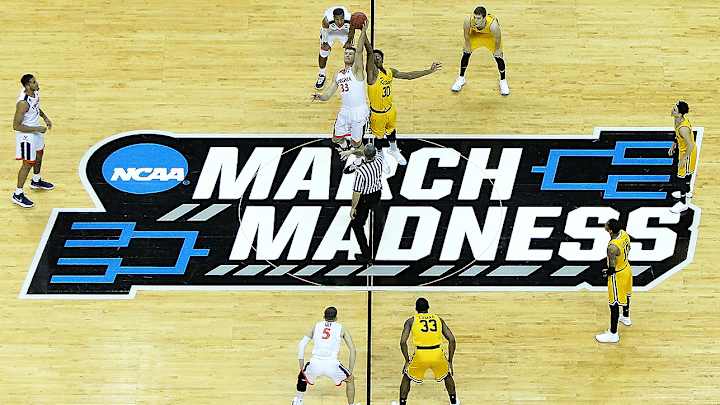
Remember the NET rankings? First announced over the summer, the NET—or NCAA Evaluation Tool—drew nearly universal backlash in late November when its first rankings were released with Ohio State in the No. 1 spot, Loyola Marymount somehow checking in at No. 10, and teams like Tennessee and Kentucky being outside of the top 25 altogether. This was supposed to be the NCAA’s overdue replacement of the long-maligned RPI? Twitter lit up with scorn. On ESPN, Jay Bilas said he would “scrap the NET” rankings if he were in charge. Analytics guru Nate Silver tweeted that they were “the worst rankings I’ve ever seen in any sport, ever.”
Still, as many including Bilas pointed out, given that the formula was at that point using just two weeks of data, some distortion was to be expected. With a much larger sample size, the NET rankings are now much more palatable upon first glance. Its current top six teams—Virginia, Duke, Gonzaga, Tennessee, Michigan, and Michigan State—are the same top six as in both the current AP poll and kenpom.com’s efficiency-based rankings; no one among its top 25 teams jumps out as being unworthy among that group. At the very least, the NET is at least no longer looking like a categorical misstep.
But a more recent and specific criticism appears valid. Two weeks ago, LSU coach Will Wade said that Alabama did his team a favor by dribbling out the final possession of the Tigers’ recent nine-point win over the Tide. His reasoning: that while the NET may cap its measurement of victory margin at 10 points, its use of teams’ raw per-possession efficiency margins as a criterium means that even when a game’s outcome is not in doubt, a team has incentive to either run up the score or continue pushing for buckets.
Buy or Sell: Are These Teams' January Efforts for Real?
Wade’s words came to mind when I set out this week to look at the differences between the NET rankings and the RPI, which is still being calculated and displayed at places like RealTimeRPI.com. After noticing that both Kansas (1st in RPI, 19th in NET) and Oklahoma (6th in RPI, 30th in NET) were particularly impacted by the change in measurement, I decided to look at the effect on the Big 12 as a whole. Five of its 10 teams (and four of its top five by RPI) fared worse in the NET than in the RPI, while the other five fared better—two of whom jumped from the middle of the conference as measured by RPI to the top in NET:
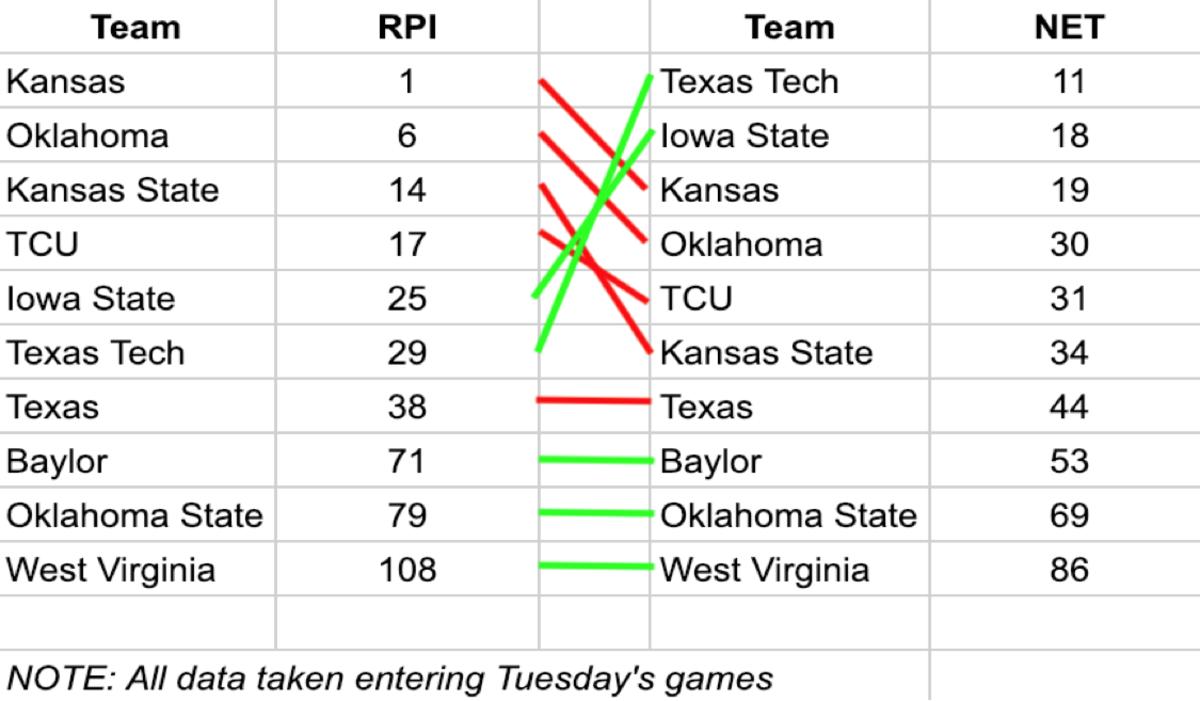
What do Texas Tech and Iowa State have in common? It can’t be strong performances in road games—an intended emphasis by the NET—since Texas Tech didn’t play a true road game before Big 12 play and Iowa State played just one, which it lost. One thing the Red Raiders and Cyclones did have in common was the league’s largest average scoring differential and, accordingly, its best raw efficiency margins.
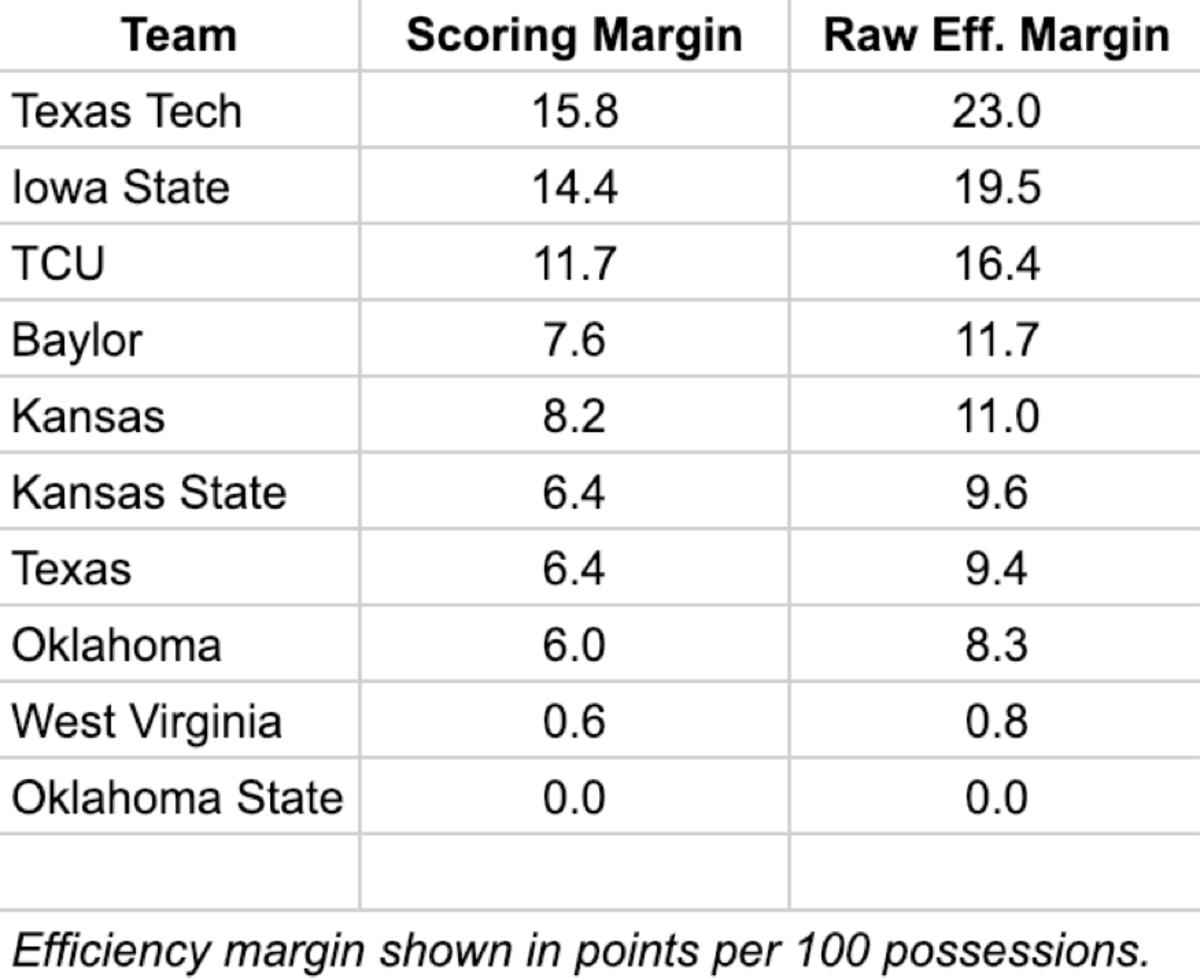
Needless to say, there are a variety of factors in play here, not all of them readily apparent since the NCAA has thus far declined to disclose the NET’s actual calculation beyond its five criteria. But given that the new system does away with the RPI’s potential punishment for playing weak teams (even in the case of beating them) and factors in net efficiency margin without accounting for the quality of opponent, its positive impact on a team like Texas Tech—which opened the season pounding three teams ranked below 300 on kenpom, then a month later smothered two more—is certainly worth noting.
It’s not just in the Big 12 that this effect is observable. Florida, which is 10–7, would be 80th nationally in RPI, but ranks 35th in NET; half of its wins have come by 20 or more points. North Carolina State began this season with five straight blowouts over sub-300 kenpom teams and handily beat three more ranked below 280 later; the Wolfpack are by my count the single biggest beneficiary of the switch from RPI to NET, ranking 26th in the latter rather than 112th in the former.
This is also good news for mid-majors, whose inherently weaker schedules can now do them less harm and even benefit them in the form of opportunities to accumulate opponent-neutral possessions of higher efficiency. Fittingly, among the notable risers in the switch from RPI to NET: Murray State (from 89 to 45), Wofford (from 45 to 30), San Francisco (from 57 to 38), and Utah State (from 59 to 41). In each of those cases, the use of raw efficiency margin over an opponent-adjusted model gives their profile a boost:
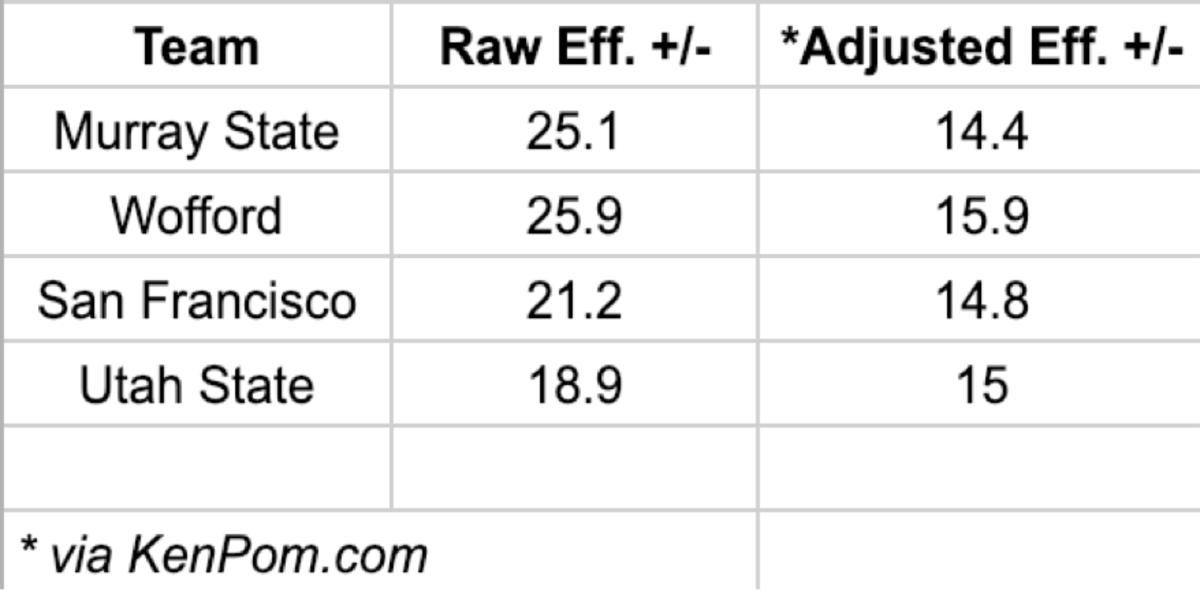
None of this is necessarily bad. Scoring margin has been shown to be valuable in objective evaluation (and also passes the basic logic test of a team that beats its opponents by 25 points per game probably being better than one that beats those same teams by five) and its complete absence from the RPI was one of that formula’s clearest flaws.
Where it gets tricky is that once those in charge know that the scoring margin—uncapped in the form of efficiency differential—matters, they can try to engineer it. (There’s a reason the subjects of an experiment knowing its variables can skew the results.) “That’s why we want to pour it on and make sure our offensive and defensive efficiency numbers are where they need to be,” Wade said earlier this month, according to The Times-Picayune. As they learn to navigate this new NET-driven world, coaches may be more encouraging of running up the score. When it comes to scheduling, the elimination of the RPI’s punishment for playing cupcakes and this reward for net efficiency could result in teams scheduling efficiency-boosting bottom feeders in nonconference play. (And with the NET’s adjusted winning percentage giving road wins more than twice the value of home wins, might a bubble-conscious team dare to kill two birds with one stone and hunt for a blowout road win? If it gets an ACC team in a MAAC gym, count me in.)
But that’s a matter for down the road. For now, teams looking to buff up their March résumés can keep one thing in mind: for better or worse, every possession counts.
If you are wondering what exactly you are reading, this is the Midweek Rebound, SI.com’s weekly Wednesday column on college hoops. If there’s anything you like or dislike or would want to see more of here, or if you would just like to share your Royal Rumble predictions, you can find me on Twitter @thedangreene. Thanks for reading.
ICYMI
Less than three weeks ago, Kansas State’s season seemed to be settling into a wrong-way trajectory, having slipped from being the preseason No. 12 to unranked thanks to an uninspiring 10–4 start that included no strong wins, a troubling loss at Tulsa and a foot injury to star forward Dean Wade, who was said to be out indefinitely. It was good enough news when Wade came back from a six-game absence on Jan. 12, but it’s only gotten better since: beginning with the game before Wade’s return, the Wildcats have won five in a row, including wins at Iowa State and Oklahoma and home wins against TCU and, on Tuesday, Texas Tech.
The result: Kansas State is now tied with Kansas at 5–2 atop the Big 12, putting it very much in a strong position within the conference's ever-evolving title chase. That observation comes with some caution: the league’s other recent It teams, Iowa State and Texas Tech, have both taken their lumps since ascending to the role of The Team That Might Finally Knock Off the Jayhawks. But with this new contender emerging and Kansas having to reinvent itself with center Udoka Azubuike out for the year, the Big 12 race is getting as interesting as it has been in some time. If nothing else, it should be known that anyone who wrote off Kansas State spoke too soon. But who would have done that?
High Five
1. Duke: The Blue Devils passed their first full-game test without Tre Jones with flying colors, beating previously undefeated Virginia by two at home. That’s enough to make that even-more-shorthanded loss to Syracuse last week feel like even more of an aberration.
2. Michigan State: The Spartans have looked as good as anybody over the last month or so, even with Joshua Langford sidelined. One big reason has been the progression of junior Cassius Winston into an All-America-level point guard.
3. Kansas State: Wade’s return has been huge, but so has the play of guard Barry Brown, who is averaging 20.4 points on 61.5% shooting from the field during the Wildcats’ five-game win streak. K-State’s defense is up to fourth nationally in adjusted efficiency.
4. Baylor: A home win over Texas Tech and a win at West Virginia—just after Kansas lost in Morgantown—have the Bears suddenly a half-game back in the Big 12 standings and creeping into the early bubble conversation.
5. Prairie View A&M: One good way to forget about a 1–11 start during a grueling seven weeks of nothing but road games? A 5–0 start in SWAC. The Panthers’ defense has been the conference’s stingiest in January.
Top of the Classes
Senior: Mike Daum, South Dakota State forward
Playing all 40 minutes of the Jackrabbits’ win over North Dakota, the Dauminator scored 34 points and grabbed 21 rebounds (to go with three assists and two blocks), the eighth 20–20 game in college hoops this season.
Junior: Ky Bowman, Boston College guard
After a 14-point, 12-rebound, seven-assist effort in a loss at Louisville, the 6’ 1” Eagles star went for 37 points on 13-of-18 shooting and pulled down nine boards in an upset of Florida State.
Sophomore: Ja Morant, Murray State guard
What a week it was for the Racers point guard, who put up 27 points and nine assists against Eastern Illinois and then went off for 40 and 11 against SIU Edwardsville—and got a perfectly-timed profile from SI’s Jeremy Woo in this week’s magazine.
Freshman: Zion Williamson, Duke forward
Don’t look now, but Zion is actually getting even better. After his 27 points, nine rebounds, and two steals against Virginia and 25 points (on 11-of-14 shooting), seven rebounds, and seven assists against Pitt, his numbers are even better in ACC play than before it.
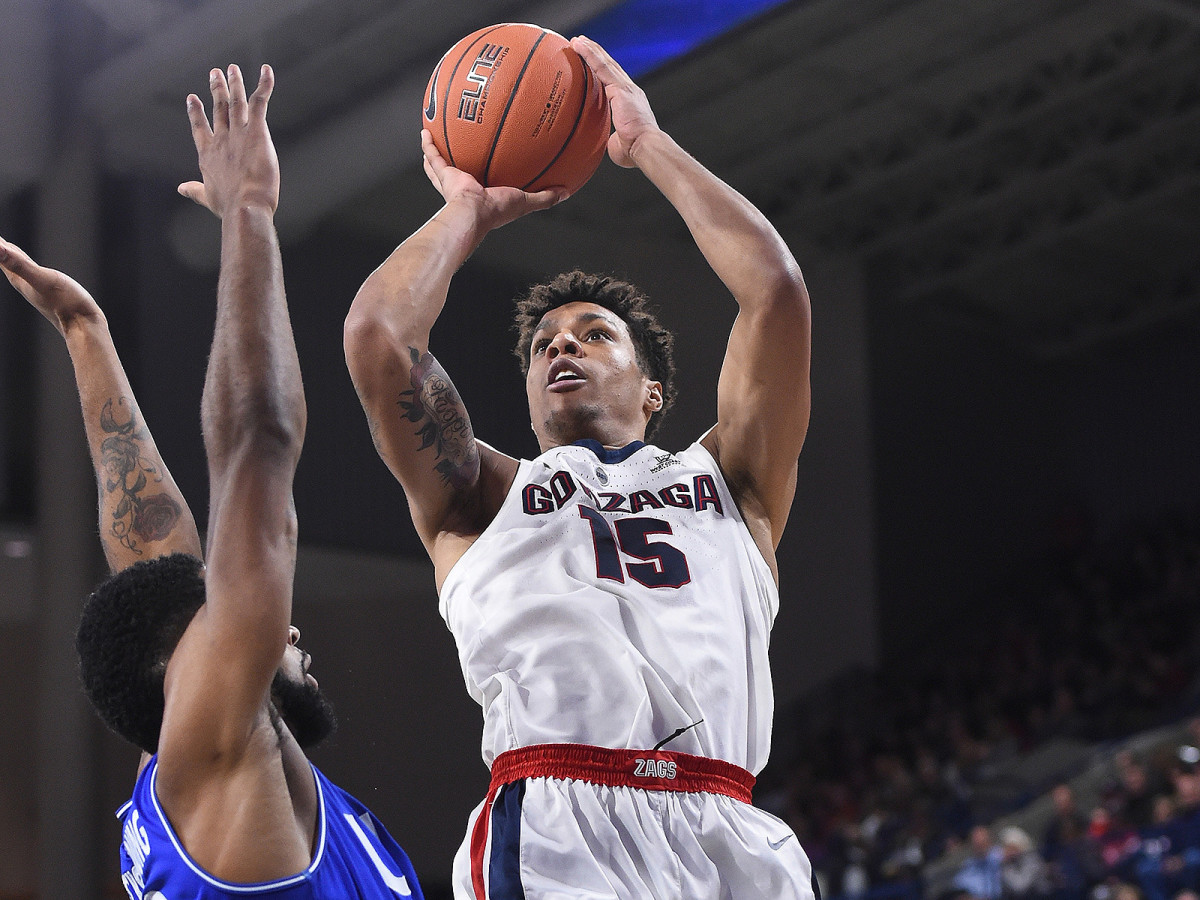
Bests of the Best
Each week, we’ll get to know one of the country’s best players a little better by asking them what they consider to be the best in various subjects. This week we welcome Gonzaga forward Brandon Clarke, who is averaging 16.5 points, 7.8 rebounds, and 3.1 blocks for the No. 4 Bulldogs. So, Brandon, tell us about the best...
...decoration in your dorm. “I have a really big poster of Canada that shows all the cities and it’s really graphic too, so it has a bunch of colors—it really pops out. I’m from Canada, so I always like to look at it. It’s in my room by my TV. I got it from a coffee shop last year. It was pretty cheap but it’s something I hold dearly.”
...movie you’ve seen in the past year. “Avengers: Infinity War. I’m a really big Marvel fan. I’ve probably seen it close to 10 times. I’d say Spider-Man is my favorite. Growing up, I used to always be him for Halloween.”
...thing about the Pacific Northwest. “There’s honestly so much. I like all the nature here, and the weather honestly. I did grow up in Phoenix [for 14 years] and it was always super hot there. I grew up in the desert, so it’s definitely nice to be able to be around trees and a bunch of green. In the summer Coach Few will take the team out on his boat, which is always really beautiful, seeing all the trees and houses around the lake.”
Social Media Post of the Week
As a general rule, your outrage at a ref’s call is rendered somewhat less vitriolic if you’re dressed like a taco pic.twitter.com/jDVEit4akg
— John Gasaway (@JohnGasaway) January 19, 2019
One to Watch: Kansas at Kentucky, Saturday at 6 p.m. ET on ESPN
The marquee matchup of this weekend’s SEC/Big 12 Challenge brings together two bluebloods in different stages of figuring themselves out. Kentucky began its season on the wrong side of a whooping from Duke and later dropped close ones to Seton Hall and Alabama, but the Wildcats have since started to mature into something more like the contender they were pegged to be. The emergence of freshman guard Ashton Hagans, a relentless tone-setter especially on the defensive end, has been a key part of catalyzing the Cats’ growth, while sophomore forward PJ Washington has stepped up of late as a scorer. The Jayhawks’ setback came more recently, when Udoka Azubuike suffered a hand injury that will sideline him the rest of the season, forcing Bill Self to deploy a four-guard lineup around star forward Dedric Lawson. Results have been mixed, with a surprising loss at last-place West Virginia bookended by narrow home wins over Iowa State and Texas. This trip to Lexington should give a good idea where they stand and make for the weekend’s best watch.
